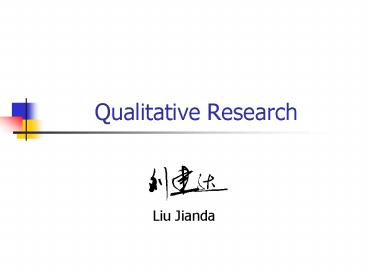Qualitative Research - PowerPoint PPT Presentation
1 / 19
Title:
Qualitative Research
Description:
Nature of Data: 'soft data' such as words or text ('verbatims'), audio, pictures, film ... NUDIST: large datasets, structured coding, mimic quant analysis ... – PowerPoint PPT presentation
Number of Views:65
Avg rating:3.0/5.0
Title: Qualitative Research
1
Qualitative Research
- Liu Jianda
2
What is Qualitative Research?
- Collecting, analyzing, and interpreting data by
observing what people do and say - Examples
- Focus groups
- Depth interviews
- Projective techniques
- Observation (human or mechanical)
3
What is Qualitative Data?
- Verbal
- interviews
- focus groups
- Speeches
- Written
- diaries
- Letters
- Books
4
Data gathering strategies
- Taking notes, either as a participant-observer or
an observer. - Conducting unstructured or semi-structured
interviews (a type of survey) or focus groups and
transcribing them. - Obtaining relevant documents or audiovisual
images. - The researcher may combine the use of two or more
data gathering techniques, and may also keep a
journal to record his or her own reflections and
tentative interpretations as the study
progresses.
5
Differences in Research Approaches
- QUALITATIVE
- Objective to gain a deeper understanding of
behaviors, inner thoughts feelings, and
meanings - Nature of Data soft data such as words or
text (verbatims), audio, pictures, film
- QUANTITATIVE
- Objective to quantify sample findings and
generalize these results to the population of
interest - Nature of Data mostly numerical
6
Differences in Research Approaches
- QUANTITATIVE
- Sample large statistical samples
- Data Collection highly structured,
standardized - Data Analysis statistical
- Outcome recommend a final course of action
- QUALITATIVE
- Sample small representative samples, often
judgment sampling - Data Collection unstructured or semi-structured
- Data Analysis data synthesis, interpretation,
themes - Outcome develop an initial or deeper
understanding
7
Different Approaches to Research4 Rs versus
4 Ps
8
Tasks by Research Activity
9
Quantitative and Qualitative Research Activities
10
Stages in analysing qualitative data
- Transcription
- Reading and Familiarisation
- Coding
- Themes/sub themes
- Develop into networks, concepts, models
11
The Data Analysis Process
12
(No Transcript)
13
Methods of Analysis
- Content analysis
- Discourse Analysis
- Narrative analysis
- Grounded theory
14
Grounded Theory
- Developed by Glaser Strauss (1967) during
investigations of institutional care of
terminally ill patients - Involves identification and integration of
categories of meaning from data - Provides researcher with an explanatory
framework to understand the phenomenon being
studied
15
Developing a Research Question
- Researchers require an initial question upon
which to focus their attention in the
area/phenomenon they select - Question should identify but not make assumptions
about the phenomenon of interest. How are the
articles acquired by the students? Rather than
How do the students acquire the articles by
reading grammar books? - Q should be open-ended and should not employ
constructs derived from existing theories/models - Initial question can change radically during the
GT process
16
Steps in Grounded Theory
- 1. Data collection
- 2. Data Storage
- 3. Coding
- 4. Memo writing
- 5. Outcomes
- Stages are not mutually exclusive (ie analysis
carried out alongside data collection)
17
Coding
- Three kinds of coding used in GT
- 1. Open coding to find categories
- 2. Axial coding to find links
- 3. Selective coding to find core category
18
Dis/Advantages of using GT
- Pros
- accounts for data
- holistic grasp of data
- Cons
- research could potentially be never ending
- hypothesis/research questions generated only
applicable to your data
19
Computer Software
- NUDIST large datasets, structured coding, mimic
quant analysis - NVivo less data, unstructured coding, find
patterns/relationships in codes - Hyperresearch
- Winmax Pro































